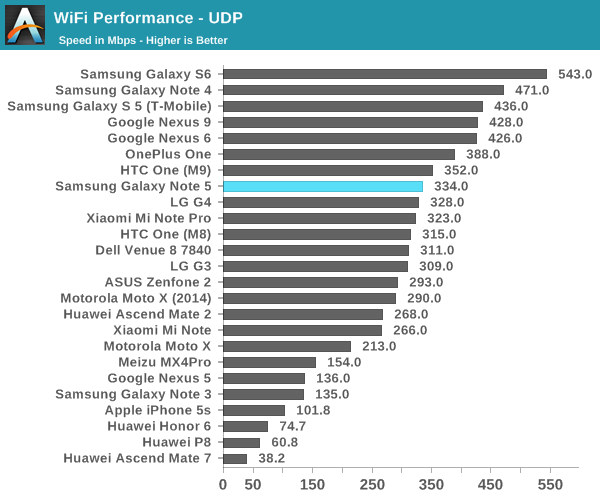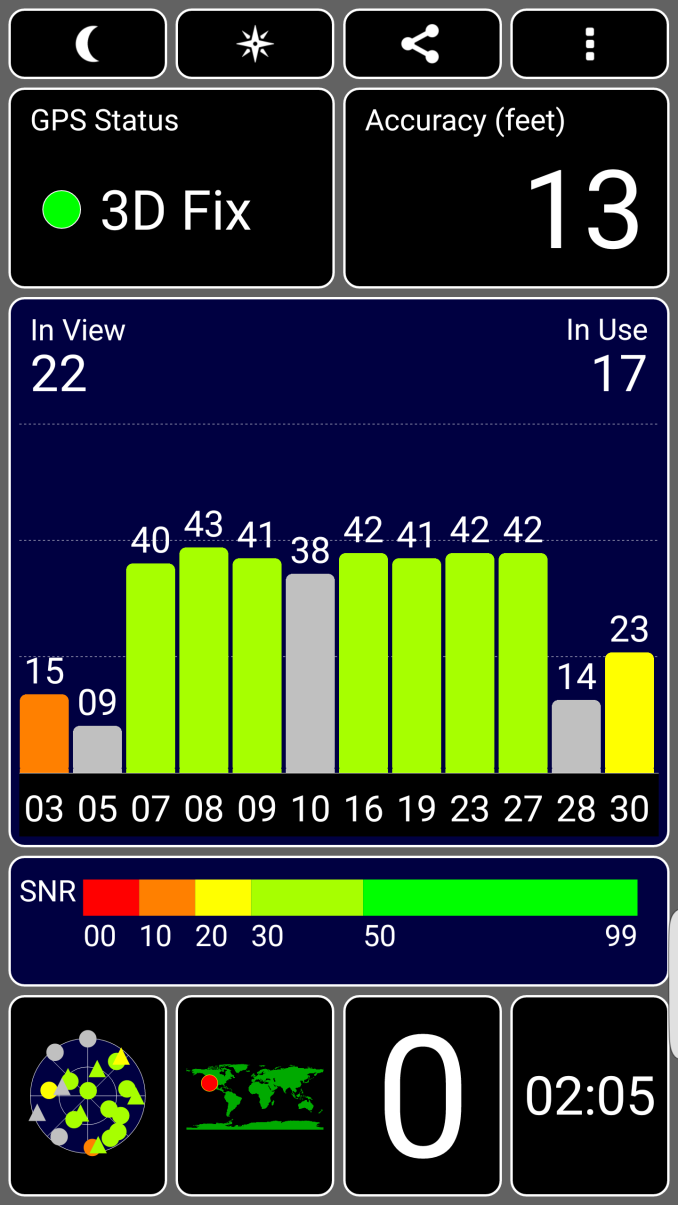The Samsung Galaxy Note5 and Galaxy S6 edge+ Review
by Joshua Ho on October 2, 2015 8:00 AM ESTVideo Performance
Now that we’ve taken a look at still image performance, we can look at video performance. For the most part these results should be similar to still image performance, but we’re looking at encoder efficiency, good sound recording, and effective stabilization. The Galaxy Note5 and Galaxy S6 edge+ both have OIS in order to improve stability in video recording, and for the most part the feature set of both is similar to the Galaxy S6 when it comes to video.
Galaxy Note5
Galaxy S6
Galaxy Note5
iPhone 6
For 1080p30, Samsung has elected to use 17Mbps High Profile H.264, along with a 256 Kbps stereo audio channel encoded with AAC. If this sounds familiar, it's because this is shared with the Galaxy S6. Quality is indistinguishable. Unfortunately, it seems the same sort of jerky OIS reset effect is still present although it isn't too obvious in these videos.
Galaxy S6
iPhone 6
It probably goes without saying, but once again the Galaxy Note5 shares the same video encode settings with the Galaxy S6, with 28 Mbps High Profile H.264 encoding for 1080p60 video. In these samples you can more clearly see the issues that come with OIS in video, which is that there are instances of jerky video movement when it should be relatively smooth, even if it's shaky. The only real difference between the Galaxy S6 and Note5/S6 edge+ is that the Note5 removes a bit of the yellow tinge/saturation boost that we see in the Galaxy S6. There's otherwise relatively little to comment on here.
Once again, not much is different when comparing the Galaxy Note5 and Galaxy S6 edge+ to the Galaxy S6 other than saturation differences in some cases. The same encoder settings are also used for 48 Mbps HP H.264 with 256 Kbps AAC stereo audio.
Galaxy Note5
Galaxy S6
Galaxy Note5
iPhone 6
If you're able to read the trend, you can probably guess that the Galaxy Note5 and S6 edge+ are going to share the same encode profiles as the Galaxy S6, which is 48Mbps HP H.264. Once again, quality is effectively identical here and the changes are slim to none. This unfortunately means that the iPhone 6 still leads here as the quality of the slow motion video on the Galaxy Note5 and Galaxy S6 line weren't much good to begin with.
WiFi Performance
For the most part, it probably goes without saying that one of the cornerstones of a smartphone or phablet is mobile data. After all, without mobile data you’re effectively limited by whatever WiFi hotspot you can find, which is often limited in range. Comparatively speaking, mobile data is generally more versatile. However, in the case of most mobile devices WiFi is often used at home in order to utilize a normally lower-latency connection with generally higher throughput. Given the reality of data caps, WiFi is also often needed for things like app updates, video streaming, and possibly music streaming. As a result, poor WiFi can sink a phone. In order to try and get a basic measure of performance, we look at peak UDP bandwidth using iPerf. In the case of the Galaxy Note 5, Samsung has upgraded the WiFi chipset from the BCM4358 used in the Galaxy S6 to Broadcom’s BCM4359. This is supposed to allow connections to 2.4 and 5 GHz WiFi simultaneously, but in practice it doesn’t really look like it’s used outside of potentially faster scanning.

Interestingly, I was unable to get the download speeds that I was expecting from a 2x2 802.11ac WiFi solution despite using 5 GHz. It's possible that this is due to interference as I can't isolate the system from other WiFi hotspots in the area, but in my experience I never had any real issues with WiFi that I could notice. Reception doesn't seem to be any better or worse than other devices I've tried in recent memory.
GNSS Performance
GNSS is often critical to a mobile device these days, as a number of applications rely on highly accurate location in order to work properly. Probably the most obvious case here is going to be GPS navigation, but things like lost/stolen device location, geofencing, location-based check-ins, and other applications are all generally quite reliant on accurate location that only GNSS systems can provide. In the case of the Galaxy Note5 and Galaxy S6 edge+, we see that the GNSS module is shared with the Galaxy S6 for the Shannon modem variants as a BCM4773 GNSS location hub is present within the system.
In practice, I didn’t find much wrong with this solution. Time to first lock without any assistance data took about 30 seconds, and at the 46 second mark the maximum possible accuracy was achieved. With assistance data, a position fix was reported within 5 seconds of launching the GPS Test app. Overall, I doubt anyone will face any real problems dealing with GPS/GNSS location on these devices.











225 Comments
View All Comments
forgot2yield28 - Friday, October 2, 2015 - link
How about a Moto X Pure review? I'm sure I'm not alone in wanting to get your take on how it stacks up against the big Samsung and Apple phones.danbob999 - Friday, October 2, 2015 - link
I would like to see screen-off and idle battery tests. Most of the time my phone sits on the table, receiving emails in the background.Dobson123 - Friday, October 2, 2015 - link
THIS! I got some bad battery numbers with the S6 in idle mode with an active internet connection (WLAN and LTE), don't know what causes this.Shark321 - Friday, October 2, 2015 - link
Agreed. My phone sits around with screen off 90% of the day.WoodyPWX - Friday, October 2, 2015 - link
Great review as always, thank you!plonk420 - Friday, October 2, 2015 - link
just a side note, in your comparisons between phones, why does the Lumia 735 (one i'm pondering) and a few others have a handful of lights reflecting? odd setup on your behalf? or is the CCD actually picking that up?JoshHo - Friday, October 2, 2015 - link
I believe this is some extra lighting Brett uses, not a sensor issue.zimmybz - Friday, October 2, 2015 - link
Dude... I can //feel// your disdain by reading written words. This review was clearly a chore. It's such a "meh" effort.I understand you prefer Apple products, and in this case, I can even readily admit that the 6S Plus is probably going to trounce this phone.
I used to come here because there was very little non-technical (specs don't lie) bias in your reviews. I guess those days are gone now.
Here is the major problem - some of us just don't LIKE iOS. It has nothing to do with whether or not it's a technically superior device year to year or whether it has a this or a that.
Reviews like this are what made me stop clicking a lot of other places. I can appreciate that you like iOS better. But an unbiased review of the product in which I can't hear you saying "whatever, it's not an iPhone" the entire time is not what Anandtech used to be.
zimmybz - Friday, October 2, 2015 - link
That last line should read: But a biased review of the product....Ryan Smith - Friday, October 2, 2015 - link
"I understand you prefer Apple products"While we appreciate the feedback all the same, just to be clear here, Josh is a day-to-day Android user. Which is not to say that he doesn't do a thorough job on both kinds of phones, but I hope you aren't ignoring a good article just because of misconceptions about the author.=)